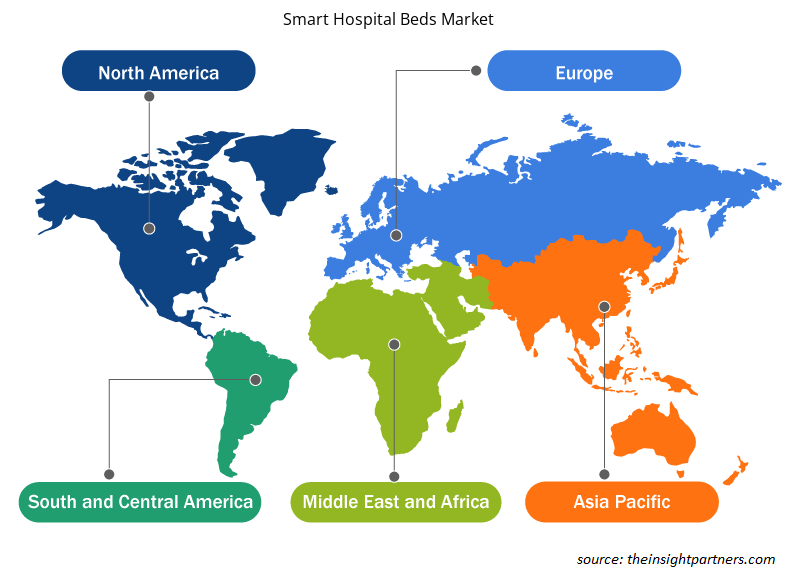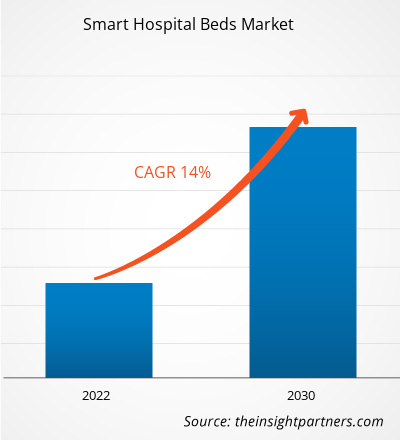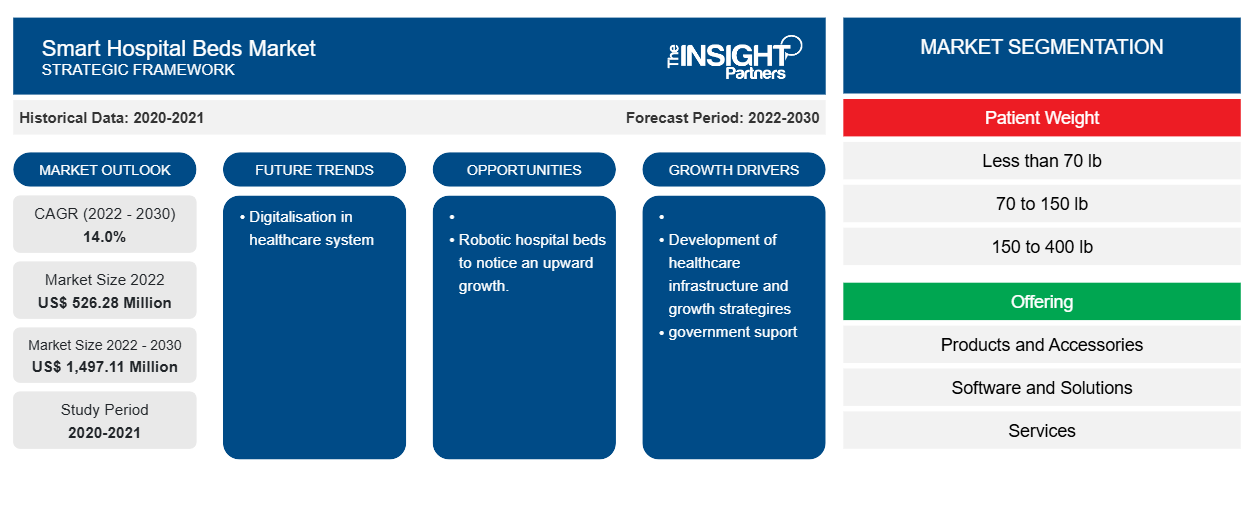스마트 병원 침대 시장 규모는 2022년 5억 2,628만 달러에서 2030년까지 1,497.11만 달러로 성장할 것으로 예상됩니다. 이 시장은 2022~2030년 동안 14.0%의 CAGR을 기록할 것으로 예상됩니다. 의료 시스템의 디지털화는 시장의 주요 트렌드로 남을 가능성이 높습니다.
스마트 병원 침대 시장 분석
스마트 병원 침대 공급업체의 의료 인프라와 성장 전략의 개발은 스마트 병원 침대 시장 의 주요 원동력으로 작용합니다 . 혁신과 업그레이드는 의료 부문이 새로운 기술을 도입하도록 유도하거나 장려합니다. 또한 정부는 최첨단 기술을 갖춘 병원을 건설하기 위해 적절한 자금을 제공함으로써 전 세계적으로 의료 인프라를 개선하기 위해 강력한 노력을 기울이고 있습니다. 2021년 2월, Hillrom은 Centrella Smart+Bed를 강화하기 위해 EarlySense로부터 3,000만 달러 상당의 비접촉 연속 모니터링 기술을 인수했습니다. Centrella Smart+Bed는 분당 100단위 이상의 심박수와 호흡수를 모니터링하도록 설계되었습니다. 따라서 스마트 병원 침대 공급업체의 의료 인프라와 성장 전략의 개발은 시장 성장을 촉진할 가능성이 높습니다.
스마트 병원 침대 시장 개요
의료 시스템의 디지털화는 스마트 병원 침대 시장의 미래 트렌드로 작용합니다. 의료 기술의 발전은 의료 센터 및 기타 환경에서 통합 기술을 통합하여 디지털 인프라를 확보할 것으로 예상됩니다. 원격 진료와 같은 디지털 기술은 스마트 병원 침대 와 통합할 수 있는 기회를 보여줍니다 . 따라서 원격 진료 기능이 있는 스마트 병원 침대는 의사 상담을 제공하는 원격 서비스를 통해 효과적임이 입증되었습니다. 따라서 스마트 병원 침대는 원격 진료를 통해 홈 케어 환경과 커뮤니티에서 유사한 치료를 제공하여 향후 몇 년 동안 시장 성장을 촉진할 것으로 예상됩니다.
귀하의 요구 사항에 맞게 이 보고서를 사용자 정의하세요
이 보고서의 일부 또는 국가 수준 분석, Excel 데이터 팩을 포함하여 모든 보고서에 대한 사용자 정의를 무료로 받을 수 있으며 신생 기업 및 대학을 위한 훌륭한 혜택과 할인 혜택을 이용할 수 있습니다.
- 이 보고서의 주요 시장 동향을 알아보세요.이 무료 샘플에는 시장 동향부터 추정 및 예측까지 다양한 데이터 분석이 포함됩니다.
스마트 병원 침대 시장 동인 및 기회
병원의 기술적으로 진보된 스마트 침대가 시장을 선호합니다
스마트 침대는 효과적인 환자 서비스를 가능하게 하는 기술적으로 진보된 사양을 포함합니다. 또한, 이러한 스마트 병원 침대는 병원의 간호 부서에 경고 알림을 보내는 데 사용할 수 있는 모니터링 시스템이 장착되어 있어 필요한 움직임을 번거롭지 않게 만들어 환자의 빠른 회복을 가능하게 합니다. 통신을 통해 간호사는 환자 상태와 중요한 기능을 원격으로 모니터링할 수 있습니다. 더욱이 스마트 침대는 이제 원격 센서와 결합되어 더 나은 의료 인프라에 기여합니다. 따라서 환자에게 더 나은 서비스를 제공하기 위한 기술적으로 진보된 스마트 침대는 상당한 시장 점유율을 차지하는 글로벌 스마트 병원 침대의 주요 원동력 중 하나입니다.
로봇 병원 침대는 수익성 있는 시장 기회를 제공할 것입니다
독일 인공지능 연구 센터(DFKI GmbH)의 2020년 4월 보도자료에 따르면, 독일 연방 교육 연구부(BMBF)는 2020년 3월에 시작하는 프로젝트 "AdaMeKoR"에 따라 병원 침대용 로봇 시스템과 센서 솔루션을 개발하기 위해 170만 달러(180만 유로)의 자금을 지원한다고 발표했습니다. AdaMeKoR 프로젝트는 로봇 병원 침대를 통해 독일 병원의 직원과 의료진의 부담을 해소하는 것을 목표로 시작되었습니다 . 따라서 로봇 병원 침대는 병원 직원의 전반적인 웰빙을 개선하여 시장 성장을 주도하는 수익성 있는 시장 기회를 제공할 것입니다.
스마트 병원 침대 시장 보고서 세분화 분석
스마트 병원 침대 시장 분석에 기여한 주요 세그먼트는 환자 체중, 제공 사항, 응용 프로그램 및 최종 사용자입니다.
- 환자 체중을 기준으로 스마트 병원 침대 시장은 70파운드 미만, 70~150파운드, 150~400파운드, 400~500파운드, 500파운드 초과로 세분화됩니다. 70파운드 미만 세그먼트는 2022년에 더 큰 시장 점유율을 차지했습니다.
- 제공을 통해 시장은 제품 및 액세서리, 소프트웨어 및 솔루션, 서비스로 세분화됩니다. 소프트웨어 및 솔루션 부문은 2022년에 시장에서 가장 큰 점유율을 차지했습니다.
- 응용 프로그램별로 시장은 낙상 예방, 압박 손상 예방, 환자 악화 및 모니터링, 기타로 세분화됩니다. 낙상 예방 부문은 2022년에 시장에서 가장 큰 점유율을 차지했습니다.
- 최종 사용자별로 시장은 병원, 진료소 및 요양원, 외래 수술 센터, 의료 실험실, 장기 요양 센터 등으로 세분화됩니다. 병원 및 솔루션 부문은 2022년에 시장에서 가장 큰 점유율을 차지했습니다.
지역별 스마트 병원 침대 시장 점유율 분석
스마트 병원 침대 시장 보고서의 지리적 범위는 주로 북미, 아시아 태평양, 유럽, 중동 및 아프리카, 남미 및 중부 아메리카의 5개 지역으로 나뉩니다.
북미가 시장을 지배했습니다. 북미 지역에서 미국은 스마트 병원 침대 시장에서 가장 큰 점유율을 차지합니다. 이 지역의 최고 제조업체와 혁신적이고 기술적으로 진보된 스마트 침대가 시장 지배에 기여하는 요인입니다. 아시아 태평양 지역은 향후 몇 년 동안 가장 높은 CAGR로 성장할 것으로 예상됩니다.
스마트 병원 침대 시장 지역 통찰력
Insight Partners의 분석가들은 예측 기간 동안 스마트 병원 침대 시장에 영향을 미치는 지역적 추세와 요인을 철저히 설명했습니다. 이 섹션에서는 북미, 유럽, 아시아 태평양, 중동 및 아프리카, 남미 및 중미의 스마트 병원 침대 시장 세그먼트와 지리에 대해서도 설명합니다.

- 스마트 병원 침대 시장에 대한 지역별 데이터 얻기
스마트 병원 침대 시장 보고서 범위
| 보고서 속성 | 세부 |
|---|---|
| 2022년 시장 규모 | 5억 2,628만 달러 |
| 2030년까지 시장 규모 | 1,497.11백만 달러 |
| 글로벌 CAGR (2022-2030) | 14.0% |
| 역사적 데이터 | 2020-2021 |
| 예측 기간 | 2022-2030 |
| 다루는 세그먼트 | 환자 체중별
|
| 포함된 지역 및 국가 | 북아메리카
|
| 시장 선도 기업 및 주요 회사 프로필 |
|
스마트 병원 침대 시장 참여자 밀도: 비즈니스 역학에 미치는 영향 이해
스마트 병원 침대 시장 시장은 소비자 선호도의 변화, 기술 발전, 제품의 이점에 대한 인식 증가와 같은 요인으로 인해 최종 사용자 수요가 증가함에 따라 빠르게 성장하고 있습니다. 수요가 증가함에 따라 기업은 제품을 확장하고, 소비자의 요구를 충족하기 위해 혁신하고, 새로운 트렌드를 활용하여 시장 성장을 더욱 촉진하고 있습니다.
시장 참여자 밀도는 특정 시장이나 산업 내에서 운영되는 회사나 기업의 분포를 말합니다. 주어진 시장 공간에 얼마나 많은 경쟁자(시장 참여자)가 존재하는지 그 규모나 총 시장 가치에 비해 나타냅니다.
스마트 병원 침대 시장에서 활동하는 주요 회사는 다음과 같습니다.
- 힐롬 홀딩스 주식회사
- 스트라이어 코퍼레이션
- B. 브라운 SE
- 아르조 AB
- 인바케어 주식회사
- 파라마운트 침대 주식회사
면책 조항 : 위에 나열된 회사는 어떤 특별한 순서에 따라 순위가 매겨지지 않았습니다.

- 스마트 병원 침대 시장 주요 업체 개요 알아보기
스마트 병원 침대 시장 뉴스 및 최근 개발
스마트 병원 침대 시장은 1차 및 2차 연구 이후의 질적, 양적 데이터를 수집하여 평가합니다. 여기에는 중요한 기업 간행물, 협회 데이터 및 데이터베이스가 포함됩니다. 스마트 병원 침대 시장의 몇 가지 개발 사항은 다음과 같습니다.
- Wissner-Bosserhoff GmbH 회사는 새로운 침대 플랫폼 "sentida sc 및 맞춤형 컨셉" 출시를 발표했습니다. 신제품 출시는 입원 환자의 개별 이동성을 유지하고 증진하기 위한 솔루션 지향적 지원을 제공하는 것을 목표로 합니다. (출처: Wissner-Bosserhoff GmbH, 회사 웹사이트/, 2022년 5월)
스마트 병원 침대 시장 보고서 범위 및 제공물
"스마트 병원 침대 시장 규모 및 예측(2020-2030)" 보고서는 아래 영역을 포괄하는 시장에 대한 자세한 분석을 제공합니다.
- 범위에 포함된 모든 주요 시장 세그먼트에 대한 글로벌, 지역 및 국가 수준의 스마트 병원 침대 시장 규모 및 예측
- 스마트 병원 침대 시장 동향 및 운전자, 제지장치, 주요 기회와 같은 시장 역학
- 자세한 PEST/포터의 5가지 힘과 SWOT 분석
- 주요 시장 동향, 글로벌 및 지역 프레임워크, 주요 업체, 규정 및 최근 시장 개발 사항을 포괄하는 스마트 병원 침대 시장 분석
- 시장 집중도, 히트맵 분석, 유명 업체 및 스마트 병원 침대 시장의 최근 개발 사항을 다루는 산업 환경 및 경쟁 분석
- 자세한 회사 프로필
- 과거 분석(2년), 기준 연도, CAGR을 포함한 예측(7년)
- PEST 및 SWOT 분석
- 시장 규모 가치/거래량 - 글로벌, 지역, 국가
- 산업 및 경쟁 환경
- Excel 데이터세트
최근 보고서
관련 보고서
사용 후기
구매 이유
- 정보에 기반한 의사 결정
- 시장 역학 이해
- 경쟁 분석
- 고객 인사이트
- 시장 예측
- 위험 완화
- 전략 기획
- 투자 타당성 분석
- 신흥 시장 파악
- 마케팅 전략 강화
- 운영 효율성 향상
- 규제 동향에 발맞춰 대응





















 무료 샘플 받기 - 스마트 병원 침대 시장
무료 샘플 받기 - 스마트 병원 침대 시장